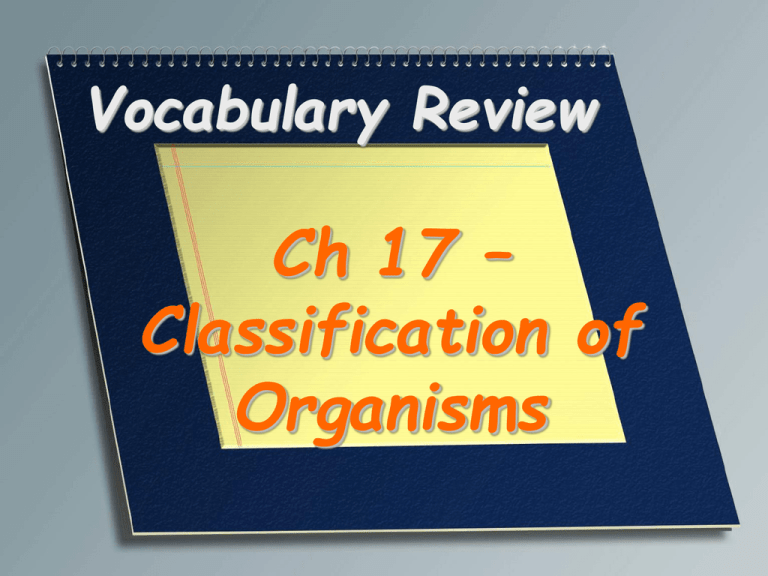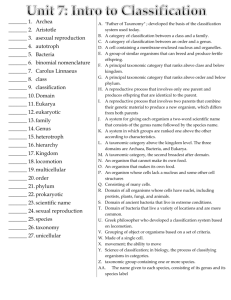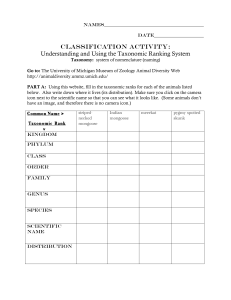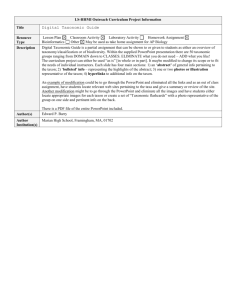Classification of Organisms Vocabulary Review PPT
advertisement

Vocabulary Review Ch 17 – Classification of Organisms The variety of organisms considered at all levels, from populations to ecosystems Biodiversity The science of describing, naming, and classifying organisms Taxonomy Any particular group within a taxonomic system Taxon In a traditional taxonomic system, the highest taxonomic category, which contains a group of similar phyla Kingdom In a modern taxonomic system, the broadest category; the category that contains kingdoms Domain In a traditional taxonomic system for organisms other than plants, the category contained within a kingdom and containing classes Phylum In a traditional taxonomic system for plants, the category contained within a kingdom and containing classes Division In a traditional taxonomic system, the category contained within a phylum or division and containing orders Class In a traditional taxonomic system, the category contained within a class and containing families Order In a traditional taxonomic system, the category contained within an order and containing genera Family In a traditional taxonomic system, the category contained within a family and containing species Genus A group of organisms that are closely related and can mate to produce fertile offspring; also the level of classification below genus and above subspecies Species A system for giving each organism a twoword scientific name that consists of the genus name followed by the species name Binomial nomenclature A taxonomic classification below species that groups organisms that live in different geographical areas, differ morphologically from other populations of the species, but can interbreed with other populations of the species Subspecies The classification of living organisms in terms of their natural relationships; it includes describing, naming, and classifying the organisms Systematics The analysis of evolutionary, or ancestral, relationships between taxa Phylogenetics A branching diagram that models the relationships by ancestry between different species or other taxonomic groups Phylogenetic diagram A phylogenetic classification system that uses shared derived characters and ancestry as the sole criterion for grouping taxa Cladistics A feature that is shared by all members of a particular group of organisms Shared character A feature that evolved only within a particular taxonomic group Derived character A taxonomic grouping that includes only a single ancestor and all of its descendants Clade A diagram that is based on patterns of shared, derived traits and that shows the evolutionary relationships between groups of organisms Cladogram In a modern taxonomic system, a domain made up of prokaryotes that usually have a cell wall and that usually reproduce by cell division; this domain aligns with the traditional kingdom Eubacteria Bacteria In a modern taxonomic system, a domain made up of prokaryotes that can live in extreme environments and that are differentiated from other prokaryotes by various important chemical differences; this domain aligns with the traditional kingdom Archaebacteria Archaea In a modern taxonomic system, a domain made up of all eukaryotes; aligns with the traditional kingdoms Protista, Fungi, Plantae, and Animalia Eukarya In a traditional taxonomic system, a kingdom that contains all prokaryotes except Kingdom Archaebacteria Eubacteria In a traditional taxonomic system, a kingdom made up of prokaryotes that can live in extreme environments; differentiated from other prokaryotes by various important chemical differences Archaebacteria In a traditional taxonomic system, a kingdom made up of mostly one-celled eukaryotic organisms that are not readily classified as either plants, animals, or fungi Protista In a traditional taxonomic system, a kingdom made up of nongreen, eukaryotic organisms that get food by breaking down organic matter and absorbing the nutrients, reproduce by means of spores, and have no means of movement Fungi In a traditional taxonomic system, a kingdom made up of eukaryotic, multicellular organisms that have cell walls made mostly of cellulose, that have pigments that absorb light, and that supply energy and oxygen to themselves and to other life-forms through photosynthesis Plantae In a traditional taxonomic system, a kingdom made up of complex, multicellular organisms that lack cell walls, are usually able to move around, and possess specialized sense organs that help them quickly respond to their environment Animalia




